The following information on semiautomatic Mauser rifles comes from Chapter 23 of Mauser Rifles and Pistols by W. H. B. Smith. Mauser Rifles and Pistols is also available to purchase in print.
Model 98. Mauser Semi-Automatic Rifle
The success of the original Mauser automatic pistol encouraged the great inventor to turn his developing talents to an attempt to create a military rifle in which mere pressure on the trigger would be sufficient to fire each succeeding shot.
The Model 98 was the first rifle of this sort produced by Mauser which proved at all practical. However, it was never in general production and will normally be encountered only in rifle collections.
The original German Reich patent No. 105619 covers the use of the turning lever or valve type of action designed by Mauser. Modifications of this system were used in a wide variety of later arms. It was not until its appearance in the Russian light machine gun, the Degtyarov which first saw service in the Civil War in Spain, that this locking principle was developed as a truly efficient mechanical design.

Later German designs, notably the semi-automatic Kar. 43 which the Germans employed in the closing years of World War II to some extent, also used a modification of this original system of operation. While this latter was a gas rifle, and the original Model 98 as introduced by Mauser was a short-recoil operated rifle, it should be noted that the locking principle is equally applicable to both operating systems. The lock is often called a “claw block” or “valve-type” lock.

This design uses the familiar recoiling barrel which is firmly locked to the breechblock at the instant of explosion. The barrel floats within an outer barrel or casing. It is supported at its muzzle end. In these early designs, locking levers were mounted in an extension of the barrel and when the action was fully forward their rear locking arms were securely engaged in cuts in the sides of the breechblock. After the short recoil, and as the barrel hit its stop and its travel was halted, the action had moved back far enough to permit caroming action to thrust the rear of the pivoted bolt lugs in when they hit the necessary surface on the barrel extension, thereby drawing the rear locking surfaces out of engagement with the breechblock.

The breechblock then travelled back to extract and eject and compress its recoil spring in standard fashion.
The standard military type Mauser magazine holding its cartridges in staggered rows thrust a cartridge up in line to be stripped by the breechblock into the firing chamber on the return stroke when the recoil spring drove the breechblock assembly forward. As the breechblock completed its forward movement, the projecting surfaces of the bolt locks hit surfaces on the barrel extension which cammed them in to engage in cuts in the side of the breechblock.
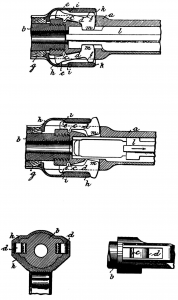
Mauser “Valve-Type” Lock For Semi-Automatic Short-Recoil Rifle (For above picture)
Top Line: Top view showing action locked. Rear ends of two locking arms are securely gripping cuts in breechblock. (“a” is receiver; “b” is barrel; “l” is breechblock; “m” and “m” are lock faces.)
Second Line: Top view showing action unlocked. As barrel and breech block traveled back locked together, when the breech pressure dropped to safe limits the cam surfaces (“e” and “e”) of the twin locks hit the slopes of the extension (at “i” and “i”), thereby camming the locks down the sides of the extension openings and out of engagement with the breechblock cuts. The barrel travel is halted at this point, but the impetus delivered to the breechblock is sufficient to carry that member back to eject, recock and reload.
Third Line: Front and side views of the locking elements.
A standard type rotating hammer which struck the firing pin in the breechblock to discharge the arm constituted the firing mechanism in this design.
A special retaining catch was incorporated in some models to permit using the arm as a single shot rifle while holding the magazine in reserve. Other features were a special barrel stop or buffer, a simple firing pin safety working through a transversely displaceable stop, and a special extractor having separate extracting claw and spring.
Model 02 Mauser Semi-Automatic Rifle
This is a long-recoil operated rifle using military cartridges, but is of very complicated design.
A long-recoil automatic weapon may be generally defined as one in which the barrel and the breechblock recoil locked together for a greater distance than the overall length of the cartridge employed.

The barrel stays locked to the breech mechanism for the full length of the unlocking stroke. The breech mechanism is then caught and held automatically by a special catch while a barrel-return spring starts moving the barrel forward to closed position. The extraction, ejection and feeding of the new cartridge takes place during forward movement of the barrel; which requires that the only time the action is really open is when the barrel is in forward motion, or is fully home.
While this system has been employed successfully on automatic shot guns such as the Remington and the Winchester, it has operated successfully in production of rifles only in the Remington self-loading rifle invented by Browning, and the Belgian Browning.

The action is much more complicated and not nearly as satisfactory for high power rifle ammunition as the short-recoil type in which barrel travel is halted after short travel, and the action opens to extract and eject on the rearward movement and to load on the forward movement of the breechblock.
This Mauser Model 1902 has a true barrel which moves back and forth in an outer barrel or barrel casing. It is locked by two symmetrically placed lugs in the breechblock which are in vertical position when locked in their recesses in the rear of the barrel chamber.

The locking lugs are carried on the front of the breechblock. As the rifle recoils when fired, the barrel and breech mechanism recoil locked together compressing the recoil spring within the receiver.
At the end of the rearward stroke, the breechblock is caught and held by a catch, while the barrel is thrust forward by its return spring. This pulling motion of the barrel drawing with it the revolvable head of the breechblock, causes the head to turn until its lugs unlock from their seatings in the barrel behind the chamber. Thus the barrel can start forward over the top of the magazine with the empty cartridge case held firmly in the grip of the extractor in the bolt head. As the case clears the forward moving barrel, it is hit by the ejector and hurled out of the rifle.
The holding catch is then automatically released, permitting the breechblock to run forward and chamber a cartridge, meanwhile producing through feathers a helical movement. This turning movement of the bolt head causes it to engage it in its locking recesses behind the base of the cartridge. The firing mechanism is of the familiar striker type.

Model 06-08 Semiautomatic Rifle
The Model 06-08 while externally the same as the other semiautos, was issued with three different lock designs, as shown in the following pictures and drawings.
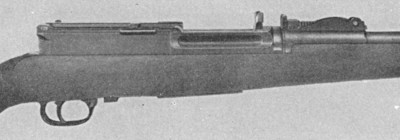




Model 06-08. Mauser Semi-Automatic Rifle. Top View With Deck Removed And Action Closed. (For image above)
This photograph shows in detail the locking system of this arm. The bright surface bearing the figure “2” is the breechblock. The extractor is mounted in the top of the breechblock. A long metal locking arm is mounted to the rear of the breechblock on each side of the recoil spring and its guide. At the moment of firing these locking lugs hold the breechblock forward while they are pressed at their rear firmly against the side of the receiver wall by the heavy guide between them. In this system, the locking is too far back from the head of the cartridge case to be really satisfactory.
This was purely an evolutionary design. This was the “Selbstlade-mit Verriegelung durch Stützflappen.” (Self-loader with lock through short flaps.) Barrel and breech mechanism recoil locked together. When pressure drops to safe limits, short steel flaps (or wings) below the breechblock are caromed out to push the locking levers out of the path of the breechblock. The barrel hits its stop and the breechblock travels back alone.

Model 06-08. Mauser Semi-Automatic Rifle. Top View With Deck Removed And Full Rear Position. (For image above)
A comparison of this photograph with that of the closed one will disclose the distance of barrel recoil by a comparison at the line of the rear sight.
At the instant of firing the barrel and breechblock are locked by the locking arms behind the breechblock being held firmly in place to support the breechblock-head. The unlocking flaps are hidden below the breechblock in this photo.
After short recoil during which pressure drops, the barrel hits its stop and is halted in rearward travel.
The forward ends of the locking arms are pushed outward, against the barrel extension by cam action of the short flaps as they turn and the breechblock continues to the rear to with the unlocked arms, indicated by the mottled steel tops, compress the recoil spring around its guide.
The photograph shows the breechblock in full rear position forced into their recesses in the barrel extension on either side of it.
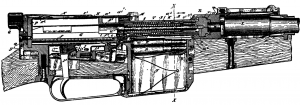
Mauser Semiautomatic Rifle With Long-Recoil Locking System (For image above)
Right side view with magazine partly loaded. The cartridge in the chamber has just been hit by the striker. All parts except the partly compressed magazine spring are shown at rest. Note the position of the locking lugs directly behind the head of the cartridge case.
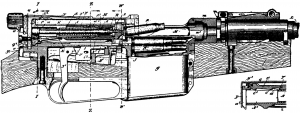
Mauser Semiautomatic Rifle With Long-Recoil Locking System (For image above)
Right side view at moment of ejection. This is the third phase in long-recoil operation. The barrel has been returned by its spring to battery position ready to load. As the barrel was pulled forward from over the empty cartridge case, the ejector was actuated to hit the case held in the face of the breechblock by the extractor, resulting in ejection as shown. As the case leaves the rifle the breechblock catch is automatically freed. The compressed operating or recoil spring in the receiver behind the breechblock now starts to push that member forward. The sear catching in its bent in the striker, holds it in readiness to be cocked.
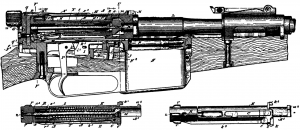
Mauser Semiautomatic Rifle With Long-Recoil Locking System (For image above)
Above: Right side view showing barrel at rear end of its recoil stroke. In this design note that the barrel slides back locked to the breech mechanism until it passes completely over the magazine. At that point the breechblock is automatically held back by its catch, and the compressed barrel return spring pulls the barrel forward. While the rear section of the breechblock is held securely by the catch, the front bolt-head section is free to turn. The barrel pulling on the bolt head acts through the feather on the bolt to twist it until the lugs come free from their seats in the receiver, thereby unlocking the action so the barrel can complete its forward movement alone.
Below: Solid and sectional views of the breech block showing its two-piece construction.
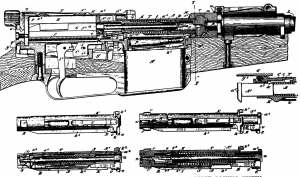
Mauser Semiautomatic Rifle With Long-Recoil Locking System (For image above)
Top Line: Right side view showing arm with chamber reloaded ready for firing. When the breechblock moved forward, its face hit the top cartridge in the magazine and drove it to the firing chamber. The rear section of the breechblock exerting pressure on the rotating bolt head in its front end, caused the feather traveling in the receiver cam groove to revolve the bolt head into locking position at the close of the forward stroke. Pressure on the trigger will fire the cartridge in the chamber and start the automatic cycle of recoiling, unlocking, ejecting, reloading, relocking and cocking.
Second and Third Lines: Solid and sectional views in fired and unlocked position and also in cocked and locked position.
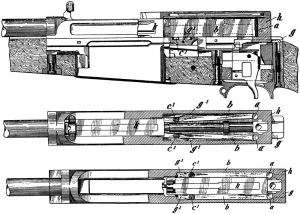
Mauser 06-08. Semi-Automatic Rifle. Detail Drawings Of The Lock. (For image above)
- Side view of action closed showing details of trigger hook up.
- Top phantom view showing action closed ready to fire. K is the breechblock which is locked. A and A are rear ends of the two bolt (or breechblock) locks, housed in recesses in the barrel extension on either side of the recoil spring guide. C and D are the center surfaces of the bolt locks G1 and G1 are the rear locking surfaces of the pivoting bolt lock releases. C1 and C1 are the forward faces of the short release (flap) locking cams in full forward position. H is a rear of the barrel extension and G is the receiver guide in which it travels.
- Top phantom view showing the action open and the arm unlocked. Note that at the end of the recoil stroke, the two pieces G1-G1 have been swung completely around by the impinging faces of the cams and the reversal of position has forced the locking arms into their recesses in the barrel extension to permit the breechblock to release the barrel.
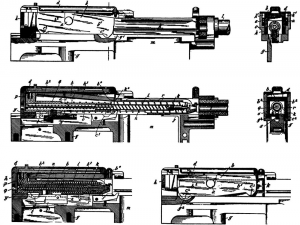
Special Mauser Short-Recoil Locking System. (For image above)
Top Line: Right side and rear detail of action. The action is fully forward and locked. Note that in this unusual design the lock is a heavy pivoting member which supports the actual breechblock at its rear. The guide tracks in the rear of the receiver indicate the distance of rearward travel of the action during recoil. (“c1” and “c2” are the lock cam faces which bring about the unlocking and locking movements).
Second Line: Right side view of weapon locked ready for firing, showing details of sear and striker construction.
Third Line: Right side views in full recoil position. (1) Side cutaway to show spring compression and ejector (f) details. (2) Details of lock member in unlocked position. On forward movement of breechblock, cam face “c2” will hit slope of receiver at “g2,” thereby pivoting the lock down into engagement.
